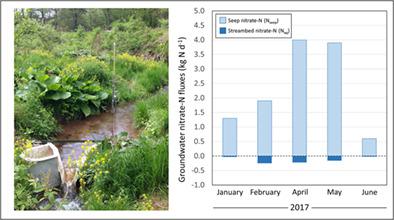当前位置:
X-MOL 学术
›
Hydrol. Process.
›
论文详情
Our official English website, www.x-mol.net, welcomes your
feedback! (Note: you will need to create a separate account there.)
Groundwater contributions of flow and nitrogen in a headwater agricultural watershed
Hydrological Processes ( IF 2.8 ) Pub Date : 2021-04-16 , DOI: 10.1002/hyp.14179 Brian W. Redder 1 , Casey D. Kennedy 2 , Anthony R. Buda 1, 3 , Gordon Folmar 3 , Elizabeth W. Boyer 1
Hydrological Processes ( IF 2.8 ) Pub Date : 2021-04-16 , DOI: 10.1002/hyp.14179 Brian W. Redder 1 , Casey D. Kennedy 2 , Anthony R. Buda 1, 3 , Gordon Folmar 3 , Elizabeth W. Boyer 1
Affiliation

|
Nonpoint sources of nitrogen (N) and other nutrients are a major source of water pollution within the Chesapeake Bay watershed and other basins around the world. Human activities associated with agricultural practices can account for a large percentage of N loadings delivered to streams and rivers. This work aims to improve understanding of N transport from groundwater to surface waters, quantifying the principal hydrological processes driving water and N fluxes into and out of a headwater agricultural stream reach. The study site is a 175-m stream reach in a heavily cultivated 40-ha watershed in east-central Pennsylvania. This subwatershed is underlain by fractured shale bedrock, and receives most of its baseflow from groundwater, either by diffuse matrix discharge through the streambed or by localized discharge through riparian seeps. Samples of stream, seep, and shallow groundwater were collected approximately monthly under steady hydrologic conditions in 2017. Calculated matrix flow from hydraulic head and conductivity measurements paired with differential stream gauging was used to solve for the riparian seep flux using a mass balance approach. Riparian seep fluxes ranged from 45 to 217 m3/d, transporting 0.6–4.2 kg N d−1 of nitrate-N from the fractured bedrock aquifer to the stream. Hydrochemical data suggest that the stream is mainly disconnected from the underlying aquifer and that seeps supply essentially all water and N to the system. Seeps are likely sourced with N in nearby agricultural fields and accelerated through the system with shorter residence times than shallow groundwater. Water isotope data reinforced this notion. This study underscores the importance of agriculture as a source of N to ground and surface waters. Identifying source areas that are causing groundwater enrichment of N and seep areas where N discharges to streams is beneficial for developing N pollution mitigation strategies and implementing management practices that aim to reduce nutrient loads to the Chesapeake Bay.
中文翻译:

上游农业流域地下水和氮的流量贡献
切萨皮克湾流域和世界其他流域内,氮(N)和其他营养物质的非点源是水污染的主要来源。与农业活动有关的人类活动可能占输送到溪流和河流的氮负荷的很大一部分。这项工作旨在增进对从地下水到地表水的氮传输的理解,量化驱动水和氮通量流入和流出农业上游水流的主要水文过程。该研究地点位于宾夕法尼亚州中东部一个占地40公顷的耕种严重的集水区,河长175米。该子集水区被裂缝性的页岩基岩所覆盖,并通过地下水的扩散基质排放或河岸渗漏的局部排放从地下水中吸收了大部分的基流。2017年,在稳定的水文条件下,大约每月采集一次河流,渗流和浅层地下水的样本。通过水力压头计算出的基体流量和电导率测量结果与差分流测量法相结合,采用质量平衡方法来解决河岸渗流。河岸渗流通量范围为45至217 m3 / d,运输0.6–4.2 kg N d -1裂缝基岩含水层中的硝酸盐氮流向河流。水化学数据表明,该溪流主要与下层含水层断开,并且渗漏基本上将所有水和N供应给系统。渗漏可能源于附近农田中的氮,并且通过该系统以比浅层地下水短的停留时间加速渗漏。水同位素数据强化了这一概念。这项研究强调了农业作为地下水和地表水氮源的重要性。确定造成地下水中氮富集的源区和向河道排放N的渗漏区,对于制定N污染缓解策略和实施旨在减少切萨皮克湾营养负荷的管理实践是有益的。
更新日期:2021-05-22
中文翻译:

上游农业流域地下水和氮的流量贡献
切萨皮克湾流域和世界其他流域内,氮(N)和其他营养物质的非点源是水污染的主要来源。与农业活动有关的人类活动可能占输送到溪流和河流的氮负荷的很大一部分。这项工作旨在增进对从地下水到地表水的氮传输的理解,量化驱动水和氮通量流入和流出农业上游水流的主要水文过程。该研究地点位于宾夕法尼亚州中东部一个占地40公顷的耕种严重的集水区,河长175米。该子集水区被裂缝性的页岩基岩所覆盖,并通过地下水的扩散基质排放或河岸渗漏的局部排放从地下水中吸收了大部分的基流。2017年,在稳定的水文条件下,大约每月采集一次河流,渗流和浅层地下水的样本。通过水力压头计算出的基体流量和电导率测量结果与差分流测量法相结合,采用质量平衡方法来解决河岸渗流。河岸渗流通量范围为45至217 m3 / d,运输0.6–4.2 kg N d -1裂缝基岩含水层中的硝酸盐氮流向河流。水化学数据表明,该溪流主要与下层含水层断开,并且渗漏基本上将所有水和N供应给系统。渗漏可能源于附近农田中的氮,并且通过该系统以比浅层地下水短的停留时间加速渗漏。水同位素数据强化了这一概念。这项研究强调了农业作为地下水和地表水氮源的重要性。确定造成地下水中氮富集的源区和向河道排放N的渗漏区,对于制定N污染缓解策略和实施旨在减少切萨皮克湾营养负荷的管理实践是有益的。











































 京公网安备 11010802027423号
京公网安备 11010802027423号